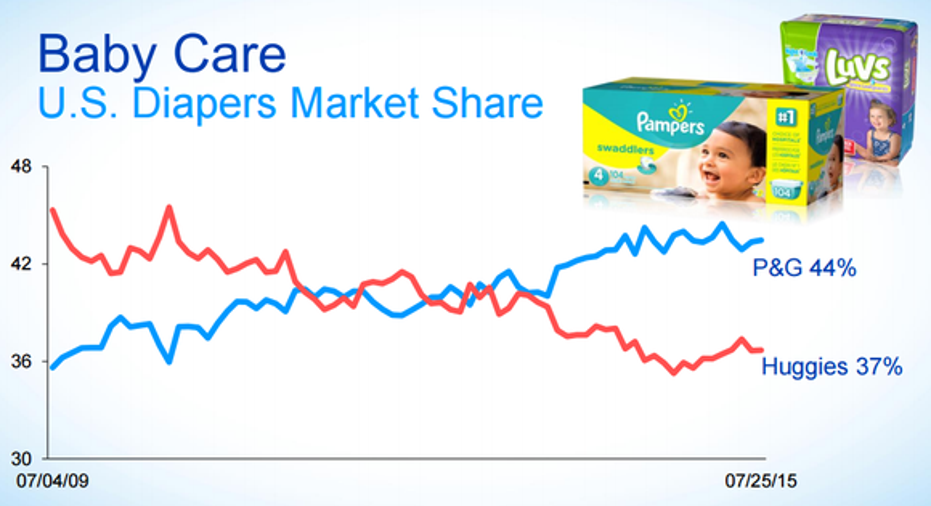What the Pampers Brand Means to Procter & Gamble Co

Procter & Gamble (NYSE: PG) boasts 21 consumer brands generating over $1 billion of sales per year, but no single brand is more important to the company than Pampers. The diaper franchise alone is responsible for $9 billion in annual revenue.
Pampers anchors the company's baby, feminine, and family care product division that's responsible for one-third of total sales and only trails behind the Tide-detergent-fueled fabric and home care unit in terms of sheer size.
Market dominance
Pampers has a dominant hold on the massive diaper industry. Last year, the brand controlled 44% of the U.S. market, compared to Kimberly-Clark'sHuggies and its 37% share.
Image source: P&G investor presentation.
The lead only grew in P&G's latest fiscal year, during which Pampers increased its market share by a full percentage point.
Pampers represents a rare win for the company, which reported market share declines in each of its five core product categories over the past year (in fact, its Luvs brand lost share in the value-based diaper niche).
It struggled against competition in areas like beauty products and grooming. Procter & Gamble's Gillette razor brand, for example, lost ground to cheaper rivals, and now that Dollar Shave Club is part of Unilever'sportfolio, growth in that segment could get even harder to find.
Innovation and marketing wins
Innovation has been key to the strong results from Pampers recently. Management credits dozens of upgrades and new launches around its Baby Dry, Swaddlers, and Cruisers lines for the market-thumping growth since 2013. Together, these wins help move the innovation needle at a time when the company is going through a creative dry spell. Procter & Gamble has failed to produce a new $1 billion product since 2005.
Image source: P&G investor presentation.
At least as important as product development is P&G's fortress-like marketing approach to promoting this brand. Besides the traditional TV and online advertising support, the company has huge prenatal programs that deliver trial versions of its products to hospitals around the country. As a result, up to 70% of new moms in the U.S. receive samples of Pampers. Procter & Gamble has a good track record ensuring that many of these test runs turn into years of brand loyalty.
A road map for growth
Pampers has all the characteristics that management values most in their portfolio. It is the leading brand in its category, with particular strength in high-income demographics. Pampers is also growing faster than the overall market, delivering precious volume gains. Finally, the products command a price premium and thus deliver a company-leading profit margin.
That's why it's helpful to look at the company's transformation strategy as an initiative to shape the P&G's entire portfolio to look more like the Pampers division. Management has divested 100 brands in the past few years, leaving only 65 that span just a few categories of consumer goods. The slimmer footprint will make the company easier to manage overall, but it should also produce a faster-growing, more profitable enterprise.
BT = Before tax. Image source: P&G.
Procter & Gamble is struggling with weak overall sales growth and an unusually long innovation slump. However, it is projecting that the coming fiscal year will mark its first one with accelerating growth since 2014. Continued dominance in the Pampers brand will be critical to hitting that goal but so will P&G's efforts to apply the success the company has seen with diapers to other areas of the business.
A secret billion-dollar stock opportunity The world's biggest tech company forgot to show you something, but a few Wall Street analysts and the Fool didn't miss a beat: There's a small company that's powering their brand-new gadgets and the coming revolution in technology. And we think its stock price has nearly unlimited room to run for early in-the-know investors! To be one of them, just click here.
Demitrios Kalogeropoulos has no position in any stocks mentioned. The Motley Fool recommends Kimberly-Clark, Procter and Gamble, and Unilever. Try any of our Foolish newsletter services free for 30 days. We Fools may not all hold the same opinions, but we all believe that considering a diverse range of insights makes us better investors. The Motley Fool has a disclosure policy.